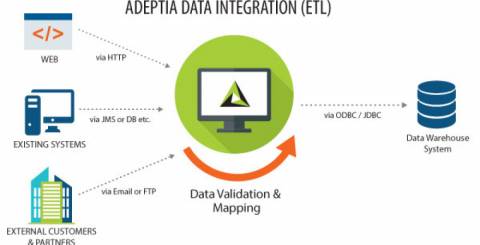Selecting the Best Data Integration Platform for your Business

Data integration platform is becoming a valuable technology for not only managing structured or unstructured data but also to aligning people, processes, and technologies. Selecting a robust data connectivity tool is tough as the market is dense with innumerable players. Before investing on an integration tool, organizations should evaluate a lot of factors. To address integration needs, a data integration tool should combine transformational and legacy systems, foster innovation, and deliver consistent data across all channels.
Here are some next generation capabilities an integration tool must promise to ensure data delivery and data delivery across all channels:
Business Intelligence (BI): Intelligence is no longer a business need but it is an imperative and business enabler. Organizations can make impactful business decisions by studying the intelligible information and augment the growth. For deriving the information, a tool should support diverse data models, predictive modeling, and Hadoop distributions.
Master Data Management (MDM): A next generation data integration tool should support MDM capabilities.The tool can be used to build flows for data access and synchronization to bring data from customer facing applications, and partner networks. It should enable synergy across multiple digital platforms and endpoints.
Uniform Data Access: Database-level consistency across applications, on internal and external systems in any direction. It should enable flexibility to ensure usability across digital touchpoints. Uniform data access prevents disruptions to business operations and ensure business continuity.
Inter Enterprise Data Sharing: Organizations need to interchange data from external trading partners. This provides the ability to address rough integration challenges and accelerate the time to revenue. Modern data integration tool should support dynamic technical environment for seamless inter enterprise data sharing.
Business Process Management: Advanced integration tools pack Enterprise State Bus (ESB) and Process management controls. Such controls support the entire data lifecycle management and also streamline processes. They establish a single source of truth to eliminate data duplication and manage processes. Advanced tools help in liberating data from silos and help users to gain more control over the processes.
Data Lake Preparation: Innumerable problems can be solved with a data lake. A modern solution should facilitate semantic and consistent approach to optimise data quality. It should also help users in integrating nonrelational structures and disparate workloads. With a robust solution, even a business user can design flows for mapping and piping data across far flung corners and prepare a futuristic data lake.
Data Migration: Data migration is another important feature of a data migration tool. A good solution moves data from one platform to upgraded version of an application. A data integration tool is expected to migrate information with automated performance optimization and metadata capabilities. Another relevant feature is service-oriented architecture (SOA) data service for enhances reusability.
Pricing: It is important to evaluate an organization's pricing and sales channel. Cost metrics like performance metrics, toolsets, and offerings must be compared. The pricing should be studied in terms of future project and scalability requirements. CIOs should evaluate that how a vendor is offering dedicating horizontal or vertical capabilities to support end user interests and integration needs.
Innovation: Next-gen integration requires synergistic layouts and templates for handling highly distributed data integration volumes. It needs to deliver optimal processing of transient data with advanced application integration approaches. Organizations should evaluate different use cases to know vendor centric capabilities that foster innovation.
The vendor should display an understanding of emerging technologies and business trends. Without market awareness they can’t ensure interoperability of systems and data quality. Tools should deliver metadata modeling, and address big data and data virtualization requirements. A good tool should provide the runtime functionality via a web services interface to manipulate and control the runtime environment.
Data Migration: Data migration is another important feature of a data migration tool. A good solution moves data from one platform to upgraded version of an application. A data integration tool is expected to migrate information with automated performance optimization and metadata capabilities. Another relevant feature is service-oriented architecture (SOA) data service for enhances reusability.
Similar Articles
The contemporary business environment demands that organizations optimize their contract processes to achieve better compliance and efficiency. This often requires enhanced digital tools and smart systems. This necessity has birthed a whole new industry specializing in contract life-cycle management.
Businesses' dependence on technology is not new. Of course, no. However, what some may not realize is this dependence has resulted in complex IT environments that frequently comprise various systems and apps.
Effectively managing uncertainty is crucial for drawing accurate conclusions. Uncertainty analysis software plays a vital role in helping researchers identify and mitigate uncertainty in models and data. However, having the software alone isn’t sufficient—proper implementation is essential to maximize its value.
React Native has continued to change the way that mobile development is done, and this excellence is still growing until now in the year 2025.
Software runs the world. It seems so, does it not? Look at businesses today: they are highly reliant on software to improve efficiency and gain a competitive advantage. This is where SaaS has emerged as the dominant model because it allows to access software via the internet.
In today’s fast-paced technological world, businesses require efficient and scalable software solutions to stay competitive. The traditional approach to software development often fails to meet the speed and flexibility required by modern enterprises. As a result, Agile methodology has become the go-to approach, but it’s not just about Agile anymore.
Adopting DevOps is revolutionizing how businesses handle software development. By integrating Development and Operations, companies can achieve greater efficiency and faster delivery times.
Businesses today have ever so subtly come to rely quite a bit on software to drive innovation. Come to think of it, software is also crucial for improving customer experience. And let us not forget that it also helps with gaining an edge over competition.
Consumer interest in fitness apps is rapidly growing, and there is no reason for it to stop. According to Statista, the global fitness application market is expected to grow to $20 billion by 2025, primarily due to growth in the usage of smartphones and customers’ awareness of health.









